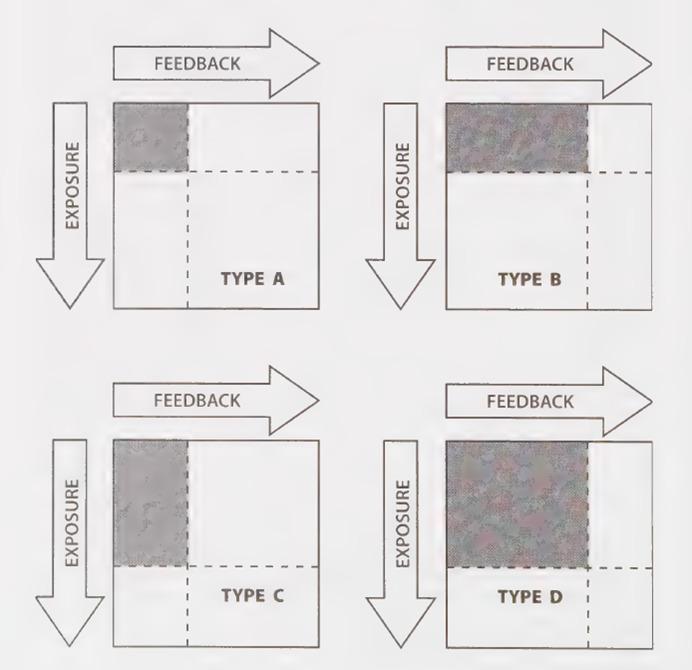-
Title
-
Interpersonal Styles as Functions of Exposure and Feedback-Individual and Individual
-
Description
-
Type A. This interpersonal style reflects a minimal use of both Exposure and Feedback processes; it is a fairly impersonal approach to interpersonal relationships. The Unknown region dominates under this style; and unrealized potential, untapped creativity, and personal psychodynamics prevail as the salient influences. Such a style would seem to indicate withdrawal and an aversion to risk-taking on the part of its user; interpersonal anxiety and safety-seeking are likely to be prime sources of personal motivation. Persons who characteristically use this style appear to be detached, mechanical, and uncommunicative. They may often be found in bureaucratic highly structured organizations of some type where it is possible, and perhaps profitable, to avoid personal disclosure or involvement. People using this style are likely to be reacted to with more than average hostility, since other parties to the relationship will tend to interpret the lack of Exposure and Feedback solicitation largely according to their own needs and how this interpersonal lack affects need fulfillment.
-
Type B. Under this approach, there is also an aversion to Exposure, but aversion is coupled with a desire for relationships not found in Type A. Thus, Feedback is the only process left in promoting relationships, and it is much overused.
An aversion to the use of Exposure may typically be interpreted as a sign of basic mistrust of self and others, and it is therefore not surprising that the Facade is the dominant feature of relationships resulting from neglected Exposure coupled with overused Feedback. The style appears to be a probing supportive interpersonal ploy and, once the Facade becomes apparent, it is likely to result in a reciprocal withdrawal of trust by other parties. This may promote feelings of suspicion on the part of others; such feelings may lead to the manager being treated as a rather superficial person without real substance or as a devious sort with many hidden agenda.
-
Type C. Based on an overuse of Exposure to the neglect of Feedback, this interpersonal style may reflect ego-striving and/or distrust of others’ competence. The person who uses this style usually feels quite confident of his own opinions and is likely to value compliance from others. The fact that he is often unaware of his impact or of the potential of others’ contributions is reflected in the dominant Blindspot which results from this style. Others are likely to feel disenfranchised by one who uses this style; they often feel that he has little use for their contributions or concern for their feelings. As a result, this style often triggers feelings of hostility, insecurity, and resentment on the part of others. Frequently, others will learn to perpetuate the manager’s Blindspot by withholding important information or giving only selected feedback; as such, this is a reflection of the passive-aggressiveness and unarticulated hostility which this style can cause. Labor-management relations frequently reflect such Blindspot dynamics.
-
Type D. Balanced Exposure and Feedback processes are used to a great extent in this style; candor, openness, and a sensitivity to others’ needs to participate are the salient features of the style. The Arena is the dominant characteristic, and productivity increases. In initial stages, this style may promote some defensiveness on the part of others who are not familiar with honest and trusting relationships; but perseverance will tend to promote a norm of reciprocal candor over time in which creative potential can be realized.
-
Designer
-
Natemeyer, Walter E, and Paul Hersey
-
Date
-
2011
-
Source
-
page 252 Natemeyer, Walter E, and Paul Hersey. Classics of Organizational Behavior. Long Grove, Ill., Waveland Press, 2011.
-
Bibliographic Citation
-
Natemeyer, Walter E, and Paul Hersey. Classics of Organizational Behavior. Long Grove, Ill., Waveland Press, 2011.
-
depict things of type
-
Typological or Classification
 Individual in Organization or Society- Basic Responses to Socialization
Individual in Organization or Society- Basic Responses to Socialization
